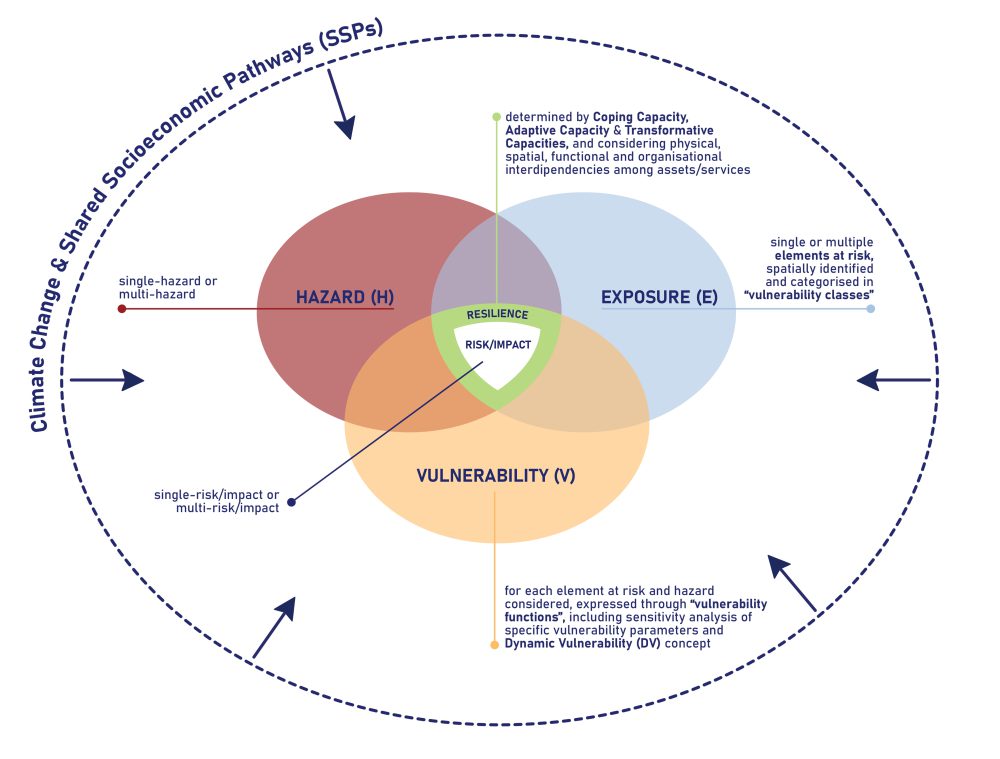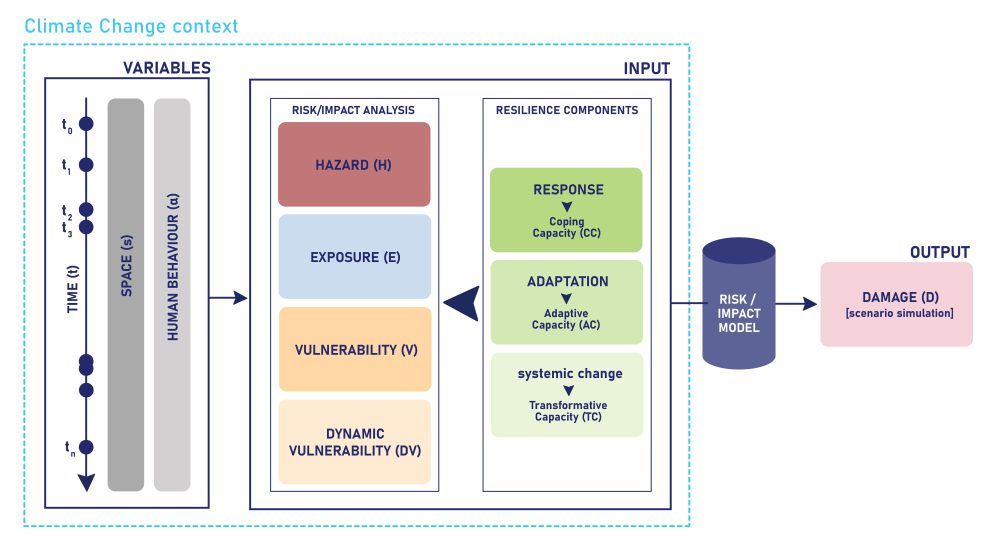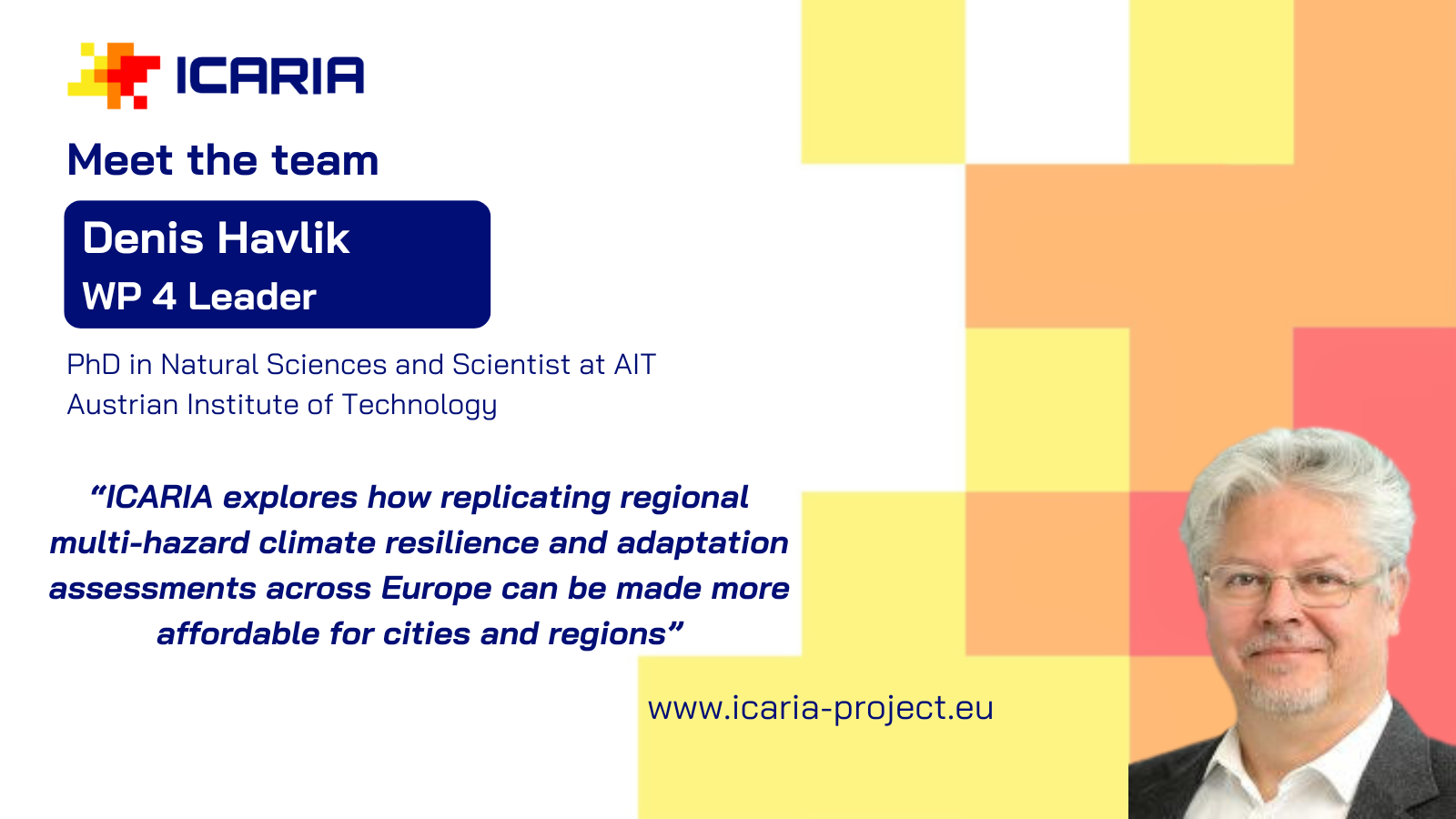
#4 | Understanding the impact of complex climate- or weather-related phenomena: The holistic asset-level modelling framework behind the ICARIA project
By Agnese Turchi (UNINA)
Over the past two decades, the frequency of climate- and weather-related disasters caused by natural events such as floods, storms, heatwaves, droughts or wildfires has increased dramatically, with severe socio-economic, technological and environmental consequences. If current temperature increases continue and the targets set by the Paris Agreement are not met, the impacts at all levels could be even more catastrophic.
Compound events such as wildfires in drought-stricken areas (coincident) or droughts followed by storm surges (consecutive) are becoming more common due to climate change. These interactions and their cascading effects can amplify the overall impact beyond that of single hazards, and the extent of damage also varies based on the relationships between multiple hazards and the risk receptors involved (e.g., people, buildings, infrastructures, services, environment, etc.). Therefore, analysis of these events, including the propagation of their effects, is crucial to guide decision-making towards strategies and measures that enhance local resilience.
Developing a framework to understand complex interactions between meteorological hazards
Risk/impact assessments of climate and weather phenomena have traditionally used single-hazard approaches, thus limiting the development of a comprehensive modelling framework for multi-hazard risk/impact assessment that also includes the evaluation of resilience level. Such a framework is extremely needed for understanding the weight of these impacts on socio-eco-technological systems, and thus defining Climate Resilient Development pathways. Moving towards a multi-hazard risk/impact assessment that integrates resilience components involves analysing the interactions between hazards and their links to global warming and climate change trends, identifying cross-sectoral implications of multi-hazard scenarios, and evaluating the effectiveness of identified resilience solutions against multiple hazards.
In this context, the ICARIA holistic asset-level modelling framework is harmonised and consistent across different hazard categories (i.e., heatwaves, droughts, forest fires, extreme winds, floods, and landslides) identified within the Barcelona Metropolitan Area, South Aegean Region and Salzburg Region case studies. It has been designed to i) build climate scenarios, ii) collect harmonised data, iii) perform exposure and vulnerability assessments of critical assets (infrastructure) and related services (linked to the water, transport, energy, and waste sectors), vi) evaluate direct and indirect damage to support the identification of suitable adaptation strategies and measures, and v) fill methodological gaps and/or uncertainties.

Figure 1. Risk/impact/resilience assessment framework. Source: Turchi, A. Tedeschi, M.F. Leone, D. De Gregorio, G. Zuccaro, A. dela Cruz Coronas, M. Bügelmayer-Blaschek, I. Zarikos, Deliverable 1.1 – Icaria Holistic Modelling Framework. ICARIA Project, 2023a.
The metodology behhind ICARIA’s framework
Based on the well-known risk equation, which expresses the probability of reaching an expected level of Damage (D) in a specific area over a certain period of time, the proposed framework within the ICARIA project provides a detailed characterisation of the so-called “elementary bricks” of Hazard (H), Exposure (E), Vulnerability (V), Dynamic Vulnerability (DV), also including Coping Capacity (CC), Adaptive Capacity (AC), and Transformative Capacity (TC) and taking into account time (t), space (s), and Human behaviour (α) variables.
| Elementary bricks | Description |
| Time (t) | Moment in which an event of a given intensity occurs. |
| Space (s) | Geographical area in which an event of a given intensity occurs. |
| Hazard (H) | Time-space distribution of the intensity of an event, characterised by an assigned probability of occurrence in a given time and space. |
| Exposure (E) | Distribution of the probability that one or more risk receptors (e.g., people, buildings, infrastructures, services, etc.), identified by assigned qualitative and quantitative characteristics, occupy a specific geographical area (i.e., space) in a specific moment (i.e., time). |
| Vulnerability (V) | Distribution of the probability that one or more risk receptors of assigned characteristics are damaged by a given hazard intensity. |
| Dynamic vulnerability (DV) | “Procedure” that updates the vulnerability of one or more risk receptors, following a sequence of events of given intensities (i.e., multi-hazard). |
| Coping capacity (CC) | Strategies/measures that individuals, organisations and/or systems use to “cope with” abrupt adverse conditions, absorbing impacts and reacting ex-post (short-term response) through all available resources. The main purpose is to restore the state of well-being as it was before the crisis. |
| Adaptive capacity (AC) | Strategies/measures that individuals, organisations and/or systems use in advance to anticipate crisis, considering what happened in past events (long-term response). The main purpose is to bring incremental changes to guarantee future well-being. |
| Transformative capacity (TC) | Capability/opportunity of individuals, organisations and/or systems to access assets/funds and be engaged in decision-making processes, with the aim of defining shared pathways for future crisis prevention and transformation of community functioning (long-term response). The main purpose is to bring incremental changes to guarantee and enhance future well-being, with a specific focus on GHG emissions reduction and SDGs achievement. |
| Damage (D) | Distribution of damage occurred on one or more risk receptors, expressed in the number of damaged elements for each damage class and/or monetary value of their restoration. |
| Human behaviour (α) | Influence factor of hazard, exposure, vulnerability, dynamic vulnerability, coping capacity, adaptive capacity, and transformative capacity. |
The methodology behind the framework (Deliverable 1.1 of ICARIA) aims to clarify relevant taxonomies, identify quantifiable risk/impact and resilience metrics, define modelling workflows applicable to different geographical contexts through the Trial (implementation) and Mini-trial (replication) phases, and make the best use of existing modelling data and methods. Primarily, the methodology focuses on modelling hazards and their aggravating precursors, together with their interrelationships, to identify triggers and cascades. It then examines the spatial distribution of the elements at risk taking into account their characteristics and associated vulnerabilities. Finally, as a service-oriented approach, it estimates how adaptation measures affect local hazard conditions, exposure, and vulnerability, using multi-criteria and cost-benefit analysis for post-processing modelling results.

Figure 2. Climate Change context. Source: Turchi, A. Tedeschi, M.F. Leone, D. De Gregorio, G. Zuccaro, A. dela Cruz Coronas, M. Bügelmayer-Blaschek, I. Zarikos, Deliverable 1.1 – Icaria Holistic Modelling Framework. ICARIA Project, 2023a.
More news

New interview about ICARIA by Beniamino Russo
Project Coordinator and Professor of Hydraulics and Hydrology at Universitat Politècnica de Catalunya – BarcelonaTech (UPC), Beniamino Russo, has interviewed... View Article

#5 | Compound climate hazards and energy challenges: Insights from Salzburg within the ICARIA project
By Marianne Bügelmayer-Blaschek (AIT) Austria, a mountainous landlocked country in Central Europe, has experienced an almost 3°C increase in average... View Article

Meet the team: Denis Havlik
Denis Havlik is a Scientist at AIT Austrian Institute of Technology and the leader of Work Package 4-Case studies: implementation,... View Article

